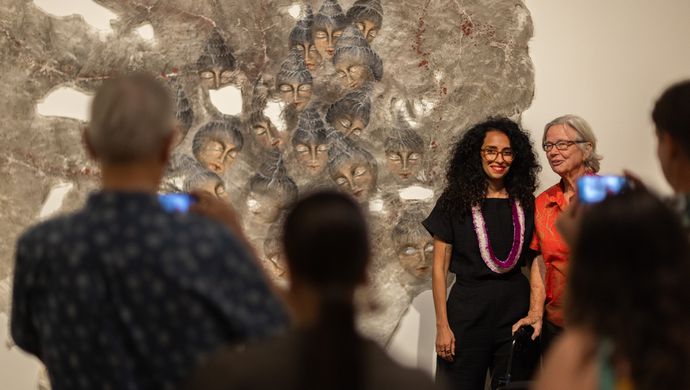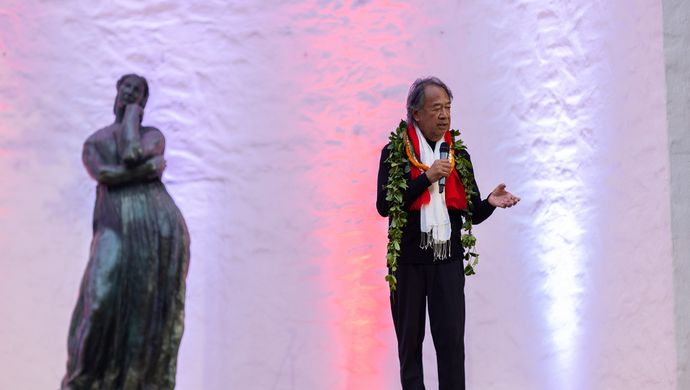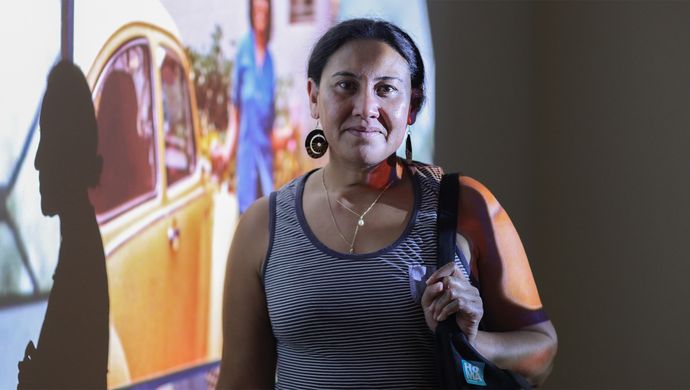 Story
Story
HT25 at HoMA: For Citra Sasmita art is a trigger to gain knowledge
Just as in the Hawaiian creation story the first human is the younger brother of the life-sustaining kalo, Balinese “believe in the relation of humans and nature,” says artist Citra Sasmita, whose installation Timur Merah Project XIV: Tribe of Fire 1–3 is on view in Hawai‘i Triennial 2025 at HoMA through May 4. “We are related to the mountains and the sea.”
Born and raised in Bali, she adds that the island has an oral tradition, which is being lost. “We are facing a crisis,” she says, while having a coffee in HoMA’s Palm Courtyard. “This kind of knowledge is not being well distributed. Even my generation doesn’t know about this anymore.”
Wanting to change that, Sasmita sought out the mentorship of a traditional artist and priestess who is passing this valuable knowledge on to her.
In her paintings in Gallery 28, trees sprout from torsos in place of heads, and hands are leafy branches, illustrating this close bond. The images are applied in acrylic paint, without the aid of previous sketches, directly onto cowhide that still bear the shape of the animal. Three hides are suspended from the ceiling, encircling a mound of charcoal.
A one-time illustrator for the Bali Post, Sasmita is a self-taught artist who drinks up information like she has been crawling through a desert. When starting out, she forged connections with artists such as the late acclaimed Bali-based artists Made Wianta (“he told me, if you want to be a successful artist you should have a concept”) and Ashley Bickerton (“coming to Hawai‘i I feel like I’m following his path”). A chance encounter led to an influential relationship with the anthropologist Urmila Mohan, who focuses on textiles in Hinduism in India and Indonesia. Through all she has learned, Sasmita has come to reimagine Balinese mythology through a feminist lens.
Sasmita normally uses traditional canvas, handmade by artisans in Bali with rice-flour glue. For her HT25 work, she went with the hide to reference the importance of cattle in the island’s culture. “The cow is used for an important ritual,” explains Sasmita, referring to animal sacrifices. “We cannot see it as violence, but rather as egalitarian distribution of food for the people.” For her, the use of cowhide is part her cultural memory.
“Timur Merah” loosely means “the east is red,” conjuring blood and fire, which can be purifying elements in these rituals. The work in HT25 is part of an ongoing series that started in 2019. In it, she turns traditional Kamasan scroll paintings on their head. Historically an art practiced by men depicting men doing heroic things according to Indonesian mythologies, Kamasan in Sasmita’s hands focus on women.
While art is taking her around the world—she just had a solo exhibition at the Barbican in London and she has an installation in the Sharjah Biennial through June 15—Sasmita finds there is nowhere like home. “I cannot leave Bali,” she says. “It’s like a recharging energy for me. There are so many things as an artist I can explore, it’s like a fountain that never ends. As a young artist there is still a lot of history I have to discover. I need to find a clue…I only make art as a trigger to gain more knowledge.”




 Interview
Interview

